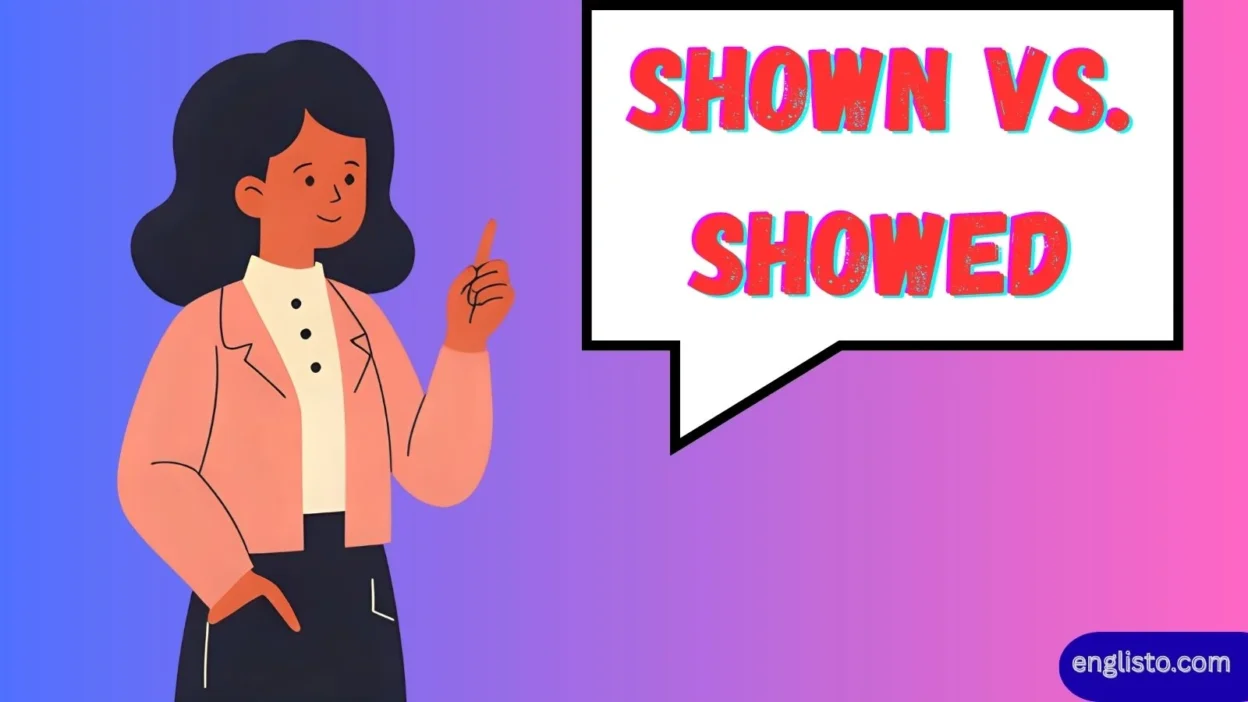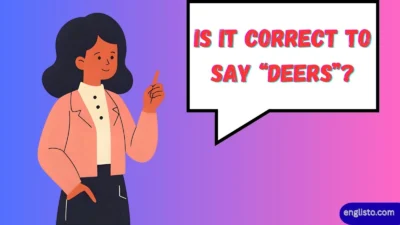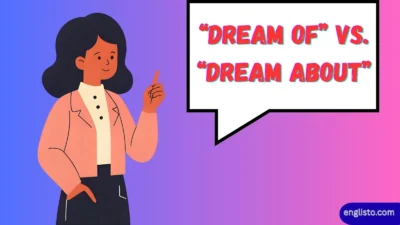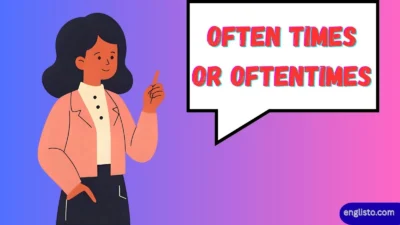Mastering English grammar often feels like solving a tricky puzzle. One of the most common stumbling blocks is knowing when to use “shown” and when to use “showed.” At first glance, they look like simple variations of the same word. But the truth is, their usage depends on tense, structure, and even the mood of your sentence. Shown vs Showed.
In this article, we’ll break down everything you need to know about shown vs. showed—from past tense to participles, from active voice to passive voice, with real-world examples, tables, and easy-to-follow rules. By the end, you’ll feel confident choosing the right word every single time.
What’s the Core Difference Between “Shown” and “Showed”?
At its heart, the difference lies in grammar:
- Showed = simple past tense (completed action at a specific point).
- Shown = past participle (used with auxiliary verbs in perfect tenses or passive voice).
Think of it like this:
| Verb Form | Example Sentence | Function |
| Showed | He showed me his work yesterday. | Simple past, active voice |
| Shown | The painting has been shown at the festival. | Past participle, perfect tense / passive voice |
Quick tip: If there’s a helping verb like have, has, had, is, was, or been, you almost always need “shown.”
Read More: Mastering Subordinate Clauses: Unlocking the Secrets of Complex Sentences
Understanding “Showed” – The Simple Past Tense
“Showed” works when you’re describing something that happened in the past and is finished. It doesn’t need a helper verb.
Examples:
- She showed me her new painting in class last week.
- The angry dog showed his teeth on the way to the station.
- They showed an incredible amount of talent during the performance.
Common Patterns with “Showed”
- Subject + showed + object
- He showed me his ID photo.
- He showed me his ID photo.
- Subject + showed + object + noun
- She showed us the secret recipe before the party.
- She showed us the secret recipe before the party.
When to Use “Showed”
- To tell a story or describe an event that’s already completed.
- To keep the sentence in active voice.
- When no auxiliary verb is present.
Exploring “Shown” – The Past Participle
“Shown” is the past participle of “show.” Past participles need helping verbs or appear in passive constructions.
Examples:
- The manuscript has been shown to the board of directors.
- The documentary was shown at the film festival.
- By the time we arrived, the realtor had already shown the homes.
Patterns with “Shown”
- has/have + shown → present perfect
- had + shown → past perfect
- will have + shown → future perfect
- was/were + shown → passive voice
Why Use “Shown”?
It emphasizes either:
- Completion – something already happened before another action.
- He had shown his guests the mansion before dinner started.
- He had shown his guests the mansion before dinner started.
- Passive focus – the object, not the doer, matters.
- The true colors of the artwork were shown under sunlight.
- The true colors of the artwork were shown under sunlight.
Active Voice vs. Passive Voice with “Shown” and “Showed”
Voice changes who the sentence focuses on—the doer or the receiver.
| Voice | Example with “Showed” | Example with “Shown” |
| Active | The teacher showed the students a documentary. | (not used in active simple past) |
| Passive | (not standard) | The documentary was shown by the teacher. |
Rule of thumb: Showed = active | Shown = passive/perfect.
Trick with Irregular Verbs
“Show” is an irregular verb, which means it doesn’t just take a neat “-ed” ending like walk → walked.
| Base | Past Simple | Past Participle |
| show | showed | shown |
Compare with other irregular verbs:
| Verb | Past | Past Participle |
| throw | threw | thrown |
| grow | grew | grown |
| know | knew | known |
| blow | blew | blown |
Notice the pattern? Many verbs ending with -n in the participle (shown, grown, known, thrown).
Real-Life Usage Examples
Everyday Conversations
- “She showed me a trick yesterday.” (simple past)
- “That trick has been shown to me before.” (perfect tense)
Reports and Studies
- “The chart showed a steady increase in profits last year.”
- “The upward trend has been shown in multiple reports.”
Storytelling
- “My brother showed his reaction during the family dinner.”
- “His reaction has been shown in reviews and interviews.”
Common Mistakes and How to Avoid Them
❌ He has showed me his work.
✅ He has shown me his work.
❌ The movie was showed at the festival.
✅ The movie was shown at the festival.
Why the mistakes happen:
People confuse “shown” with “showed” because most verbs form the past and participle the same way (work → worked → worked). But “show” breaks the pattern.
Quick Reference Table
Here’s a handy cheat sheet to keep the rules straight:
| Tense / Voice | Correct Form | Example |
| Simple Past (active) | showed | She showed me her ID. |
| Present Perfect | has/have shown | They have shown great patience. |
| Past Perfect | had shown | He had shown his guests the villa. |
| Future Perfect | will have shown | By next year, the chef will have shown his secret recipe. |
| Passive Voice | was/were shown | The jewelry was shown at the museum. |
Pro Tips for Mastering Shown vs. Showed
- Always look for helping verbs (have, has, had, was, were, will have). If they’re present → use “shown.”
- If the sentence describes a specific event in the past without a helper verb → use “showed.”
- In formal writing, “shown” is more frequent because passive and perfect tenses appear often in academic, scientific, and professional contexts.
- In casual speech, “showed” dominates since people usually stick to simple past storytelling.
Memory Hacks
- Think of shown as shone light—something already illuminated or displayed.
- Link showed to a finished show—it happened once, in the past, and it’s done.
Related Words and Synonyms
Sometimes “show” isn’t the best choice. You might use:
| Synonym | Example Sentence | Tone / Context |
| display | The painting was displayed in the gallery. | Formal, artistic |
| demonstrate | He demonstrated his skills in class. | Educational, scientific |
| exhibit | Artifacts were exhibited in the museum. | Academic, historical |
| illustrate | The graph illustrates company profits. | Reports, analysis |
FAQs on “Shown vs. Showed”
Q1: Is it ever correct to say “has showed”?
No. The correct form is always “has shown.”
Q2: Can I use “shown” without a helper verb?
Only in very rare or archaic cases (e.g., “shew” in Old English). In modern English, “shown” almost always requires a helper verb or passive voice.
Q3: Do native speakers ever mix these up?
Yes, especially in casual speech. But in writing, “has showed” or “was showed” is considered incorrect.
Q4: Which form should I use in academic writing?
Prefer “shown” because academic style often uses passive voice and perfect tenses.
Q5: Is “showed” disappearing in modern usage?
Not at all. Both forms are alive and well—just in different grammatical contexts.
Conclusion
The battle between “shown” vs. “showed” comes down to understanding verb forms.
- Use showed for simple past, active voice when talking about something finished.
- Use shown for perfect tenses and passive voice when the action’s result or the receiver matters more than the doer.
Once you train your ear to notice helper verbs and verb patterns, choosing the right word becomes second nature. Remember: He showed me his work yesterday, but his work has been shown in festivals many times.
Getting this right not only improves your grammar but also elevates your confidence in speaking and writing English.



